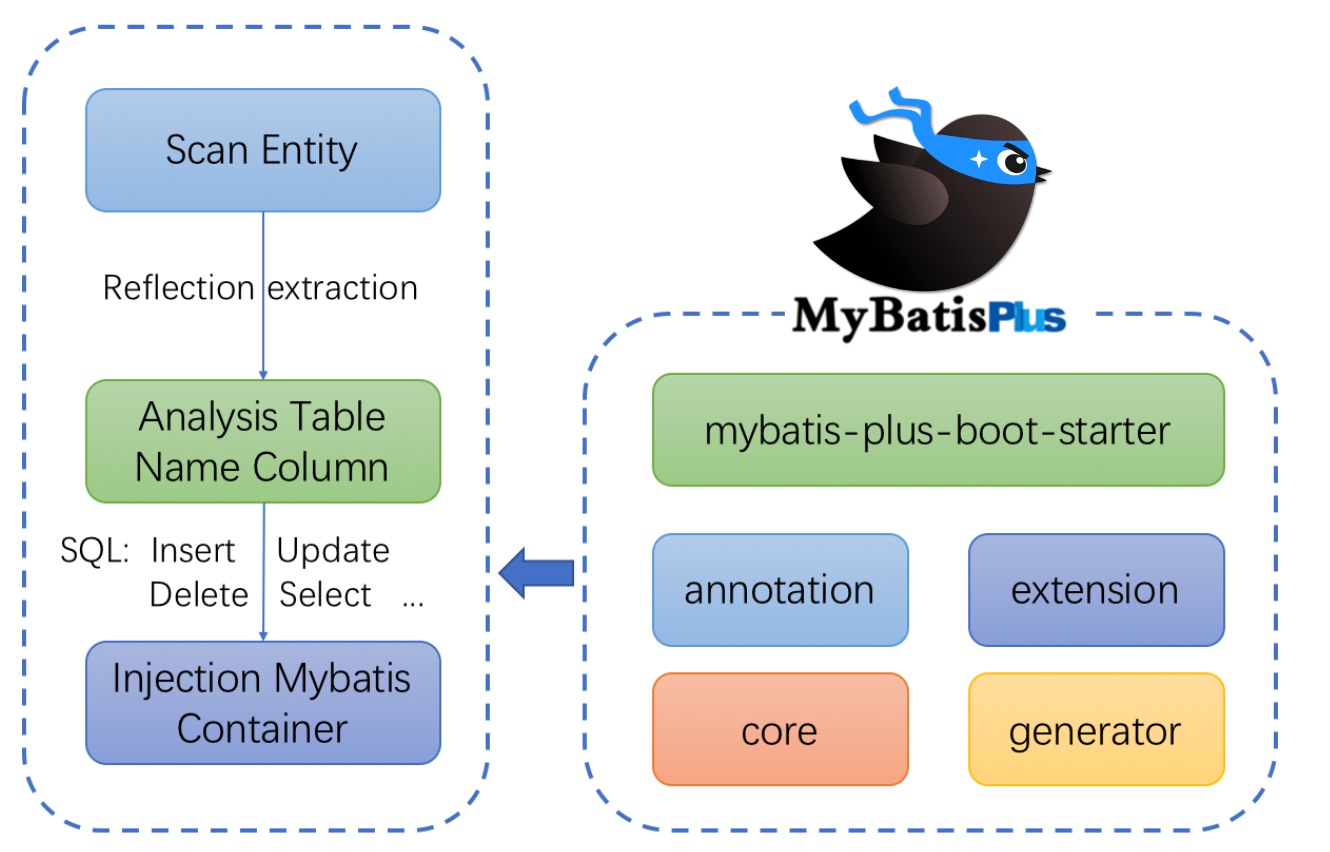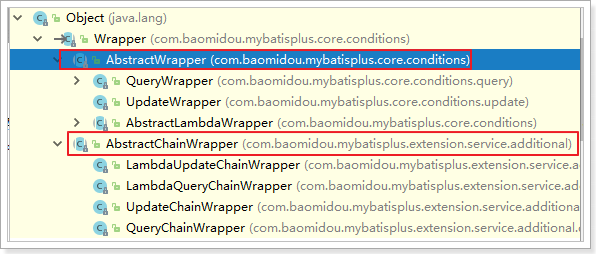MyBatis-Plus
MyBatis-Plus
一、了解Mybatis-Plus
1.1、Mybatis-Plus介绍
MyBatis-Plus(简称 MP)是一个 MyBatis 的增强工具,在 MyBatis 的基础上只做增强不做改变,为简化开发、提高效率而生。
官网:
https://baomidou.com/

愿景
我们的愿景是成为 MyBatis 最好的搭档,就像 魂斗罗 中的 1P、2P,基友搭配,效率翻倍。

1.2、特性
- 无侵入:只做增强不做改变,引入它不会对现有工程产生影响,如丝般顺滑
- 损耗小:启动即会自动注入基本 CURD,性能基本无损耗,直接面向对象操作
- 强大的 CRUD 操作:内置通用 Mapper、通用 Service,仅仅通过少量配置即可实现单表大部分 CRUD 操作,更有强大的条件构造器,满足各类使用需求
- 支持 Lambda 形式调用:通过 Lambda 表达式,方便的编写各类查询条件,无需再担心字段写错
- 支持多种数据库:支持 MySQL、MariaDB、Oracle、DB2、H2、HSQL、SQLite、Postgre、SQLServer2005、SQLServer 等多种数据库
- 支持主键自动生成:支持多达 4 种主键策略(内含分布式唯一 ID 生成器 - Sequence),可自由配置,完美解决主键问题
- 支持 XML 热加载:Mapper 对应的 XML 支持热加载,对于简单的 CRUD 操作,甚至可以无 XML 启动
- 支持 ActiveRecord 模式:支持 ActiveRecord 形式调用,实体类只需继承 Model 类即可进行强大的 CRUD 操作
- 支持自定义全局通用操作:支持全局通用方法注入( Write once, use anywhere )
- 支持关键词自动转义:支持数据库关键词(order、key......)自动转义,还可自定义关键词
- 内置代码生成器:采用代码或者 Maven 插件可快速生成 Mapper 、 Model 、 Service 、 Controller 层代码,支持模板引擎,更有超多自定义配置等您来使用
- 内置分页插件:基于 MyBatis 物理分页,开发者无需关心具体操作,配置好插件之后,写分页等同于普通 List 查询
- 内置性能分析插件:可输出 Sql 语句以及其执行时间,建议开发测试时启用该功能,能快速揪出慢查询
- 内置全局拦截插件:提供全表 delete 、 update 操作智能分析阻断,也可自定义拦截规则,预防误操作
- 内置 Sql 注入剥离器:支持 Sql 注入剥离,有效预防 Sql 注入攻击
1.3、支持的数据库
任何能使用
MyBatis进行 CRUD, 并且支持标准 SQL 的数据库,具体支持情况如下:
MySQL,Oracle,DB2,H2,HSQL,SQLite,PostgreSQL,SQLServer,Phoenix,Gauss,ClickHouse,Sybase,OceanBase,Firebird,Cubrid,Goldilocks,csiidb;- 达梦数据库,虚谷数据库,人大金仓数据库,南大通用(华库)数据库,南大通用数据库,神通数据库,瀚高数据库
1.4、框架结构

二、入门案例
MyBatis-Plus官方推荐使用Spring Boot,在此我们以Spring整合MyBatis为基础,再加入MyBatis-plus,以此来学习MyBatis-Plus相关内容。‘开发环境:
- JDK:JDK8+;
- 构建工具:Maven 3.6.3;
- MySQL:5.7+
- Spring:5.2.6.RELEASE
2.1、创建数据库以及表
-- 创建测试表
DROP TABLE IF EXISTS user;
CREATE TABLE user (
id BIGINT(20) NOT NULL COMMENT '主键ID',
name VARCHAR(30) NULL DEFAULT NULL COMMENT '姓名',
age INT(11) NULL DEFAULT NULL COMMENT '年龄',
email VARCHAR(50) NULL DEFAULT NULL COMMENT '邮箱',
PRIMARY KEY (id)
);
-- 插入测试数据
DELETE FROM user;
INSERT INTO user (id, name, age, email) VALUES
(1, 'Jone', 18, 'test1@baomidou.com'),
(2, 'Jack', 20, 'test2@baomidou.com'),
(3, 'Tom', 28, 'test3@baomidou.com'),
(4, 'Sandy', 21, 'test4@baomidou.com'),
(5, 'Billie', 24, 'test5@baomidou.com');2.2、创建工程
新建普通
Maven项目, 不要选择Maven骨架,引入MyBatis-Plus之后请不要再次引入MyBatis以及MyBatis-Spring,以避免因版本差异导致的问题。pom.xml配置如下:
<?xml version="1.0" encoding="UTF-8"?>
<project xmlns="http://maven.apache.org/POM/4.0.0"
xmlns:xsi="http://www.w3.org/2001/XMLSchema-instance"
xsi:schemaLocation="http://maven.apache.org/POM/4.0.0 http://maven.apache.org/xsd/maven-4.0.0.xsd">
<modelVersion>4.0.0</modelVersion>
<groupId>com.qfedu</groupId>
<artifactId>mybatisplus_test</artifactId>
<version>1.0.0</version>
<properties>
<maven.compiler.source>8</maven.compiler.source>
<maven.compiler.target>8</maven.compiler.target>
<spring.version>5.2.6.RELEASE</spring.version>
<mybatis-plus.version>3.5.1</mybatis-plus.version>
</properties>
<dependencies>
<dependency>
<groupId>org.springframework</groupId>
<artifactId>spring-context</artifactId>
<version>${spring.version}</version>
</dependency>
<dependency>
<groupId>org.springframework</groupId>
<artifactId>spring-test</artifactId>
<version>${spring.version}</version>
</dependency>
<dependency>
<groupId>org.springframework</groupId>
<artifactId>spring-jdbc</artifactId>
<version>${spring.version}</version>
</dependency>
<dependency>
<groupId>com.baomidou</groupId>
<artifactId>mybatis-plus</artifactId>
<version>${mybatis-plus.version}</version>
</dependency>
<dependency>
<groupId>mysql</groupId>
<artifactId>mysql-connector-java</artifactId>
<version>5.1.49</version>
<scope>runtime</scope>
</dependency>
<dependency>
<groupId>com.alibaba</groupId>
<artifactId>druid</artifactId>
<version>1.2.4</version>
</dependency>
<dependency>
<groupId>org.projectlombok</groupId>
<artifactId>lombok</artifactId>
<version>1.18.22</version>
</dependency>
<dependency>
<groupId>log4j</groupId>
<artifactId>log4j</artifactId>
<version>1.2.17</version>
</dependency>
<dependency>
<groupId>junit</groupId>
<artifactId>junit</artifactId>
<version>4.12</version>
<scope>test</scope>
</dependency>
</dependencies>
</project>2.3、Spring整合MyBatis
2.3.1、创建实体
@Data
@NoArgsConstructor
@AllArgsConstructor
public class User {
private Long id;
private String name;
private Integer age;
private String email;
}2.3.2、创建jdbc.properties
jdbc.driver=com.mysql.jdbc.Driver
jdbc.url=jdbc:mysql://localhost:3306/mybatisplus?useSSL=false&useUnicode=true&characterEncoding=UTF-8
jdbc.username=root
jdbc.password=root2.3.3、创建Spring核心配置文件
<?xml version="1.0" encoding="UTF-8"?>
<beans xmlns="http://www.springframework.org/schema/beans"
xmlns:xsi="http://www.w3.org/2001/XMLSchema-instance"
xmlns:context="http://www.springframework.org/schema/context"
xsi:schemaLocation="http://www.springframework.org/schema/beans
http://www.springframework.org/schema/beans/spring-beans.xsd
http://www.springframework.org/schema/context
http://www.springframework.org/schema/context/spring-context.xsd">
<!-- 引入连接池配置文件 -->
<context:property-placeholder location="classpath:jdbc.properties" />
<!-- 包扫描 -->
<context:component-scan base-package="com.qfedu.service.impl" />
<!-- 配置连接池 -->
<bean id="dataSource" class="com.alibaba.druid.pool.DruidDataSource">
<property name="driverClassName" value="${jdbc.driver}" />
<property name="url" value="${jdbc.url}" />
<property name="username" value="${jdbc.username}" />
<property name="password" value="${jdbc.password}" />
</bean>
<!--
配置SqlSessionFactory
-->
<bean id="sqlSessionFactory" class="org.mybatis.spring.SqlSessionFactoryBean">
<!-- 配置连接池 -->
<property name="dataSource" ref="dataSource" />
<!-- 配置别名 -->
<property name="typeAliasesPackage" value="com.qfedu.bean" />
<!-- 加载MyBatis的配置文件 -->
<property name="configLocation" value="classpath:SqlMapConfig.xml" />
</bean>
<!--
配置mapper接口的扫描配置
由mybatis-spring提供,可以将指定包下所有的mapper接口创建动态代理
并将这些动态代理作为IOC容器的bean管理
-->
<bean id="mapperScanner" class="org.mybatis.spring.mapper.MapperScannerConfigurer">
<property name="basePackage" value="com.qfedu.mapper" />
</bean>
</beans>2.3.4、创建MyBatis核心配置文件
<?xml version="1.0" encoding="UTF-8" ?>
<!DOCTYPE configuration
PUBLIC "-//mybatis.org//DTD Config 3.0//EN"
"http://mybatis.org/dtd/mybatis-3-config.dtd">
<configuration>
<settings>
<!-- 打印查询语句 -->
<setting name="logImpl" value="LOG4J" />
</settings>
</configuration>2.3.5、创建Mapper接口
import com.qfedu.bean.User;
import java.util.List;
public interface UserMapper {
List<User> findAll();
}2.3.6、创建Mapper映射文件
<?xml version="1.0" encoding="UTF-8" ?>
<!DOCTYPE mapper PUBLIC "-//mybatis.org//DTD Mapper 3.0//EN" "http://mybatis.org/dtd/mybatis-3-mapper.dtd" >
<mapper namespace="com.qfedu.mapper.UserMapper">
<select id="findAll" resultType="user">
select * from user
</select>
</mapper>2.3.7、创建Service接口及其实现类
public interface UserService {
List<User> findAll();
}
@Service
public class UserServiceImpl implements UserService {
@Autowired
private UserMapper userMapper;
@Override
public List<User> findAll() {
return userMapper.findAll();
}
}2.3.8、增加log4j配置文件
#
# Hibernate, Relational Persistence for Idiomatic Java
#
# License: GNU Lesser General Public License (LGPL), version 2.1 or later.
# See the lgpl.txt file in the root directory or <http://www.gnu.org/licenses/lgpl-2.1.html>.
#
### direct log messages to stdout ###
log4j.appender.stdout=org.apache.log4j.ConsoleAppender
log4j.appender.stdout.Target=System.err
log4j.appender.stdout.layout=org.apache.log4j.PatternLayout
log4j.appender.stdout.layout.ConversionPattern=%d{ABSOLUTE} %5p %c{1}:%L - %m%n
### direct messages to file hibernate.log ###
#log4j.appender.file=org.apache.log4j.FileAppender
#log4j.appender.file.File=hibernate.log
#log4j.appender.file.layout=org.apache.log4j.PatternLayout
#log4j.appender.file.layout.ConversionPattern=%d{ABSOLUTE} %5p %c{1}:%L - %m%n
### set log levels - for more verbose logging change 'info' to 'debug' ###
log4j.rootLogger=debug, stdout2.3.9、测试
//Spring整合Junit
@RunWith(SpringJUnit4ClassRunner.class)
@ContextConfiguration(locations = "classpath:beans.xml")
public class MyTest {
@Autowired
private UserMapper userMapper;
@Autowired
private UserService userService;
@Test
public void test1() {
userMapper.findAll().forEach(System.out::println);
}
@Test
public void test2() {
userService.findAll().forEach(System.out::println);
}
}2.4、加入MyBatis-Plus 重要
2.4.1、修改Spring核心配置文件
<?xml version="1.0" encoding="UTF-8"?>
<beans xmlns="http://www.springframework.org/schema/beans"
xmlns:xsi="http://www.w3.org/2001/XMLSchema-instance"
xmlns:context="http://www.springframework.org/schema/context"
xsi:schemaLocation="http://www.springframework.org/schema/beans
http://www.springframework.org/schema/beans/spring-beans.xsd
http://www.springframework.org/schema/context
http://www.springframework.org/schema/context/spring-context.xsd">
<!-- 引入连接池配置文件 -->
<context:property-placeholder location="classpath:jdbc.properties" />
<!-- 包扫描 -->
<context:component-scan base-package="com.qfedu.service.impl" />
<!-- 配置连接池 -->
<bean id="dataSource" class="com.alibaba.druid.pool.DruidDataSource">
<property name="driverClassName" value="${jdbc.driver}" />
<property name="url" value="${jdbc.url}" />
<property name="username" value="${jdbc.username}" />
<property name="password" value="${jdbc.password}" />
</bean>
<!--
配置SqlSessionFactory
调整SqlSessionFactory为MyBatis-Plus的SqlSessionFactory
-->
<bean id="sqlSessionFactory" class="com.baomidou.mybatisplus.extension.spring.MybatisSqlSessionFactoryBean">
<!-- 配置连接池 -->
<property name="dataSource" ref="dataSource" />
<!-- 配置别名 -->
<property name="typeAliasesPackage" value="com.qfedu.bean" />
<!-- 加载MyBatis的配置文件 -->
<property name="configLocation" value="classpath:SqlMapConfig.xml" />
<!-- <property name="globalConfig" ref="globalConfig" />-->
</bean>
<!--
配置mapper接口的扫描配置
由mybatis-spring提供,可以将指定包下所有的mapper接口创建动态代理
并将这些动态代理作为IOC容器的bean管理
-->
<bean id="mapperScanner" class="org.mybatis.spring.mapper.MapperScannerConfigurer">
<property name="basePackage" value="com.qfedu.mapper" />
</bean>2.4.2、创建Mapper接口
import com.baomidou.mybatisplus.core.mapper.BaseMapper;
import com.qfedu.bean.User;
public interface UserMapper extends BaseMapper<User> {
}
BaseMapper<T>是MyBatis-Plus提供的基础Mapper接口,泛型为所操作的实体类型,其中包括CRUD的各种方法,我们的mapper继承了BaseMapper之后,就可以直接使用BaseMapper所提供的各种方法,而不需要编写映射文件以及SQL语句,大大的提高了开发效率。注:如果要完成
BaseMapper没有的功能,还是要像之前一样定义接口,写Mapper映射文件。
2.4.3、测试
@RunWith(SpringJUnit4ClassRunner.class)
@ContextConfiguration(locations = "classpath:beans.xml")
public class MyTest {
@Autowired
private UserMapper userMapper;
@Test
public void test1() {
//查询所有
List<User> userList = userMapper.selectList(null);
userList.stream().forEach(System.out::println);
}
}总结:在
Spring整合MyBatis中加入了MyBatis-Plus后,我们就可以使用MyBatis-Plus所提供的BaseMapper实现CRUD,并不需要编写映射文件以及SQL语句。但是若要自定义SQL语句,仍然可以编写映射文件而不造成任何影响,因为MyBatis-Plus只做增强,而不做改变。
三、CRUD接口 重要
3.1、Mapper CRUD接口 重要
3.1.1、Insert
// 插入一条记录
int insert(T entity);参数说明
| 类型 | 参数名 | 描述 |
|---|---|---|
| T | entity | 实体对象 |
案例
@Test
public void testInsert() {
User user = new User(null, "张三", 20, "zs@126.com");
//INSERT INTO user ( id, name, age, email ) VALUES ( ?, ?, ?, ? )
int result = userMapper.insert(user);
System.out.println(user);
System.out.println(result);
}最终执行的结果,所获取的id为
1500813820996714498,这是因为MyBatis-Plus在实现插入数据时,会默认基于雪花算法的策略生成id。
3.1.2、Delete
// 根据 entity 条件,删除记录
int delete(@Param(Constants.WRAPPER) Wrapper<T> wrapper);
// 删除(根据ID 批量删除)
int deleteBatchIds(@Param(Constants.COLLECTION) Collection<? extends Serializable> idList);
// 根据 ID 删除
int deleteById(Serializable id);
// 根据 columnMap 条件,删除记录
int deleteByMap(@Param(Constants.COLUMN_MAP) Map<String, Object> columnMap);参数说明
| 类型 | 参数名 | 描述 |
|---|---|---|
Wrapper<T> | wrapper | 实体对象封装操作类(可以为 null) |
Collection<? extends Serializable> | idList | 主键 ID 列表(不能为 null 以及 empty) |
Serializable | id | 主键 ID |
Map<String, Object> | columnMap | 表字段 map 对象 |
案例
@Test
public void testDeleteById() {
//DELETE FROM user WHERE id=?
int i = userMapper.deleteById(1500092790474260482L);
System.out.println(i);
}
@Test
public void testDeleteBatchIds() {
//DELETE FROM user WHERE id IN ( ? , ? , ? )
Long[] ids = {1500093260177522689L, 1500093259107975169L, 1500093260244631554L};
int i = userMapper.deleteBatchIds(Arrays.asList(ids));
System.out.println(i);
}
@Test
public void testDeleteByMap() {
//DELETE FROM user WHERE name = ? AND age = ?
Map<String, Object> map = new HashMap<>();
map.put("age", 60);
map.put("name", "张三40");
int i = userMapper.deleteByMap(map);
System.out.println(i);
}3.1.3、Update
// 根据 whereWrapper 条件,更新记录
int update(@Param(Constants.ENTITY) T updateEntity, @Param(Constants.WRAPPER) Wrapper<T> whereWrapper);
// 根据 ID 修改
int updateById(@Param(Constants.ENTITY) T entity);参数说明
| 类型 | 参数名 | 描述 |
|---|---|---|
T | entity | 实体对象 (set 条件值,可为 null) |
Wrapper<T> | updateWrapper | 实体对象封装操作类(可以为 null,里面的 entity 用于生成 where 语句) |
案例
@Test
public void testUpdateById() {
//UPDATE user SET name=?, age=? WHERE id=?
User user = new User(1500813820996714498L, "zs", 20, null);
int i = userMapper.updateById(user);
System.out.println(i);
}3.1.4、Selete
// 根据 ID 查询
T selectById(Serializable id);
// 根据 entity 条件,查询一条记录
T selectOne(@Param(Constants.WRAPPER) Wrapper<T> queryWrapper);
// 查询(根据ID 批量查询)
List<T> selectBatchIds(@Param(Constants.COLLECTION) Collection<? extends Serializable> idList);
// 根据 entity 条件,查询全部记录
List<T> selectList(@Param(Constants.WRAPPER) Wrapper<T> queryWrapper);
// 查询(根据 columnMap 条件)
List<T> selectByMap(@Param(Constants.COLUMN_MAP) Map<String, Object> columnMap);
// 根据 Wrapper 条件,查询全部记录
List<Map<String, Object>> selectMaps(@Param(Constants.WRAPPER) Wrapper<T> queryWrapper);
// 根据 Wrapper 条件,查询全部记录。注意: 只返回第一个字段的值
List<Object> selectObjs(@Param(Constants.WRAPPER) Wrapper<T> queryWrapper);
// 根据 entity 条件,查询全部记录(并翻页)
IPage<T> selectPage(IPage<T> page, @Param(Constants.WRAPPER) Wrapper<T> queryWrapper);
// 根据 Wrapper 条件,查询全部记录(并翻页)
IPage<Map<String, Object>> selectMapsPage(IPage<T> page, @Param(Constants.WRAPPER) Wrapper<T> queryWrapper);
// 根据 Wrapper 条件,查询总记录数
Integer selectCount(@Param(Constants.WRAPPER) Wrapper<T> queryWrapper);参数说明
| 类型 | 参数名 | 描述 |
|---|---|---|
| Serializable | id | 主键 ID |
Wrapper<T> | queryWrapper | 实体对象封装操作类(可以为 null) |
| Collection<? extends Serializable> | idList | 主键 ID 列表(不能为 null 以及 empty) |
| Map<String, Object> | columnMap | 表字段 map 对象 |
IPage<T> | page | 分页查询条件(可以为 RowBounds.DEFAULT) |
通过观察
BaseMapper中的方法,大多方法中都有Wrapper类型的形参,此为条件构造器,可针对于SQL语句设置不同的条件,若没有条件,则可以为该形参赋值null,即查询(删除/修改)所有数据。
案例
@Test
public void testSelectById() {
//SELECT id,name,age,email FROM user WHERE id=?
User user = userMapper.selectById(1500813820996714498L);
System.out.println(user);
}
@Test
public void testSelectBatchIds() {
//SELECT id,name,age,email FROM user WHERE id IN ( ? , ? , ? )
List<User> users = userMapper.selectBatchIds(Arrays.asList(1L, 2L, 3L));
users.stream().forEach(System.out::println);
}
@Test
public void testSelectByMap() {
Map<String, Object> map = new HashMap<>();
map.put("age", 61);
map.put("name", "张三41");
//SELECT id,name,age,email FROM user WHERE name = ? AND age = ?
List<User> users = userMapper.selectByMap(map);
System.out.println(users);
}3.2、Service CRUD接口 重要
1 使Servcie层的接口继承IService,并指明泛型类型
2 使Service层的实现类继承ServiceImpl<UserMapper, T>,传入自定义的Mapper,指明实体类类型,实现自定义的Service层接口
说明:
- 通用
Service CRUD封装IService接口,进一步封装CRUD采用get查询单行、remove删除、list查询集合、page分页,前缀命名方式区分Mapper层避免混淆;- 泛型
T为任意实体对象;- 建议如果存在自定义通用
Service方法的可能,请创建自己的IBaseService继承Mybatis-Plus提供的基类;- 对象
Wrapper为条件构造器。
3.2.1、创建Servie接口和实现类
//UserService继承IService模板提供的基础功能
public interface UserService extends IService<User> {
}
/**
* ServiceImpl实现了IService,提供了IService中基础功能的实现
* 若ServiceImpl无法满足业务需求,则可以使用自定的UserService定义方法,并在实现类中实现
*/
@Service
public class UserServiceImpl extends ServiceImpl<UserMapper, User> implements UserService {
}3.2.2、测试
@RunWith(SpringJUnit4ClassRunner.class)
@ContextConfiguration(locations = "classpath:beans.xml")
public class MyTest1 {
@Autowired
private UserService userService;
@Test
public void testSave() {
User user = new User(null, "ls", 21, "abcd@126.com");
boolean save = userService.save(user);
System.out.println(save);
}
@Test
public void saveOrUpdate() {
User user = new User(100L, "tom", 22, "zs22@126.com");
boolean result = userService.saveOrUpdate(user);
System.out.println(result);
}
//求总数
@Test
public void testCount() {
long count = userService.count();
System.out.println(count);
}
@Test
public void testSaveBatch(){
ArrayList<User> users = new ArrayList<>();
for (int i = 0; i < 5; i++) {
User user = new User();
user.setName("zs" + i);
user.setAge(20 + i);
users.add(user);
}
userService.saveBatch(users);
}
}四、常用注解 重要
4.1、@TableName
4.1.1、如何使用
经过以上的测试,在使用
MyBatis-Plus实现基本的CRUD时,我们并没有指定要操作的表,只是在Mapper接口继承BaseMapper时,设置了泛型User,而操作的表为user表。由此得出结论,
MyBatis-Plus在确定操作的表时,由BaseMapper的泛型决定,即实体类型决定,且默认操作的表名和实体类型的类名一致。若实体类类型的类名和要操作的表的表名不一致,程序抛出异常。
为了解决上面的问题,在实体类类型上添加
@TableName("表名"),标识实体类对应的表,即可成功执行SQL语句。
@Data
@NoArgsConstructor
@AllArgsConstructor
@TableName("tb_user")
public class User {
private Long id;
private String name;
private Integer age;
private String email;
}4.1.2、通过GlobalConfig批量添加前缀 了解
查资料!!!
在开发的过程中,我们经常遇到以上的问题,即实体类所对应的表都有固定的前缀,例如
t_或tb_。此时,可以使用
MyBatis-Plus提供的全局配置,为实体类所对应的表名设置默认的前缀,那么就不需要在每个实体类上通过@TableName标识实体类对应的表。
<bean id="sqlSessionFactory" class="com.baomidou.mybatisplus.extension.spring.MybatisSqlSessionFactoryBean">
<!-- 配置连接池 -->
<property name="dataSource" ref="dataSource" />
<!-- 配置别名 -->
<property name="typeAliasesPackage" value="com.qfedu.bean" />
<!-- 加载MyBatis的配置文件 -->
<property name="configLocation" value="classpath:SqlMapConfig.xml" />
<!-- MyBatis-Plus 全局策略配置 -->
<property name="globalConfig" ref="globalConfig" />
</bean>
<bean id="globalConfig" class="com.baomidou.mybatisplus.core.config.GlobalConfig">
<property name="dbConfig" ref="dbConfig" />
</bean>
<bean id="dbConfig" class="com.baomidou.mybatisplus.core.config.GlobalConfig$DbConfig">
<property name="tablePrefix" value="tb_" />
</bean>4.2、@TableId
4.2.1、基本使用
经过以上的测试,
MyBatis-Plus在实现CRUD时,会默认将id作为主键列,并在插入数据时,默认基于雪花算法的策略生成id。若实体类和表中表示主键的不是
id,而是其他字段,我们将实体类中的属性id改为uid,将表中的字段id也改为uid,程序抛出异常。在实体类中
uid属性上通过@TableId将其标识为主键,即可成功执行SQL语句。
@Data
@NoArgsConstructor
@AllArgsConstructor
@TableName("tb_user")
public class User {
@TableId
private Long uid;
private String name;
private Integer age;
private String email;
}4.2.2、value属性
若实体类中主键对应的属性为
id,而表中表示主键的字段为uid,此时若只在属性id上添加注解@TableId,则抛出异常Unknown column 'id' in 'field list',即MyBatis-Plus仍然会将id作为表的主键操作,而表中表示主键的是字段uid此时需要通过
@TableId注解的value属性,指定表中的主键字段,@TableId("uid")或@TableId(value="uid")
@Data
@NoArgsConstructor
@AllArgsConstructor
@TableName("tb_user")
public class User {
@TableId(value = "uid", type=IdType.AUTO)
private Long id;
private String name;
private Integer age;
private String email;
}4.2.3、type属性
**IdType.AUTO 最常用 ** 主键生成策略
作用:指定主键类型
| 值 | 描述 |
|---|---|
| IdType.AUTO | 数据库ID自增 常用!!! |
| IdType.NONE | 无状态,该类型为未设置主键类型(注解里等于跟随全局,全局里约等于INPUT) |
| IdType.INPUT | insert前自行set主键值 |
| IdType.ASSIGN_ID | 分配ID(主键类型为Number(Long 和 Integer)或 String)(since 3.3.0),使用接口IdentifierGenerator的方法nextId(默认实现类为DefaultIdentifierGenerator雪花算法) |
| IdType.ASSIGN_UUID | 分配 UUID,主键类型为 String(since 3.3.0),使用接口IdentifierGenerator的方法nextUUID(默认 default 方法) |
关于雪花算法:
4.3、@TableField
MyBatis-Plus在执行SQL语句时,要保证实体类中的属性名和表中的字段名一致,如果实体类中的属性名和字段名不一致的情况,会出现什么问题呢?
**情况1:**若实体类中的属性使用的是驼峰命名风格,而表中的字段使用的是下划线命名风格,例如实体类属性
userName,表中字段user_name,此时MyBatis-Plus会自动将下划线命名风格转化为驼峰命名风格。**情况2:**若实体类中的属性和表中的字段不满足情况1,例如实体类属性
name,表中字段username,此时需要在实体类属性上使用@TableField("username")设置属性所对应的列名。
@Data
@NoArgsConstructor
@AllArgsConstructor
@TableName("tb_user")
public class User {
@TableId(value = "uid")
private Long id;
@TableField("username")
private String name;
private Integer age;
private String email;
}4.4、@TableLogic (逻辑删除)
4.4.1、关于删除
- **物理删除:**真实删除,将对应数据从数据库中删除,之后查询不到此条被删除的数据;
- **逻辑删除:**假删除,将对应数据中代表是否被删除字段的状态修改为
被删除状态,之后在数据库 中仍旧能看到此条数据记录; 一列(标志位 ,is_deleted : 0 未删除 1 已删除)- **使用场景:**可以进行数据恢复。
4.4.2、实现逻辑删除
步骤:
- 数据库中创建逻辑删除状态列(
is_deleted),设置默认值为0;- 实体类中添加逻辑删除属性,并在该属性上添加
@TableLogic注解
@Data
@NoArgsConstructor
@AllArgsConstructor
@TableName("tb_user")
public class User {
@TableId(value = "uid")
private Long id;
private String name;
private Integer age;
private String email;
@TableLogic
private Integer isDeleted; //0 :未删除 1:已删除
}
@Test
public void testDeleteById() {
//测试删除功能,真正执行的是修改
//UPDATE tb_user SET is_deleted=1 WHERE uid=? AND is_deleted=0
int i = userMapper.deleteById(1500822918454702085L);
System.out.println(i);
}
@Test
public void testFindAll() {
//测试查询功能,被逻辑删除的数据默认不会被查询
//SELECT uid AS id,name,age,email,is_deleted FROM tb_user WHERE is_deleted=0
List<User> users = userMapper.selectList(null);
users.forEach(System.out::println);
}五、条件构造器 重点
在MyBatis-Plus中,Wrapper接口的实现类关系如下:

可以看到,AbstractWrapper和AbstractChainWrapper是重点实现,接下来我们重点学习AbstractWrapper以及其子类。
QueryWrapper:查询条件封装 项目中常用
UpdateWrapper:Update条件封装
5.1、组装查询条件
大于gt 大于等于ge
小于lt 小于等于le
模糊查询 like 范围函数between
空 isNull 非空isNotNull
等于 eq
@Test
public void test1() {
//查询用户名包含a,年龄在20到30之间,并且邮箱不为null的用户信息
//SELECT uid AS id,name,age,email,is_deleted FROM tb_user WHERE is_deleted=0 AND (name LIKE ? AND age BETWEEN ? AND ? AND email IS NOT NULL)
QueryWrapper<User> queryWrapper = new QueryWrapper<>();
queryWrapper.like("name", "a") // 链式写法 name like '%a%'
.between("age", 20, 30)
.isNotNull("email");
List<User> list = userMapper.selectList(queryWrapper);
list.forEach(System.out::println);
}5.2、组装排序条件
升序 orderByAsc
降序 orderByDesc
@Test
public void test2() {
//按年龄降序查询用户,如果年龄相同则按id升序排列
//SELECT id,username AS name,age,email,is_deleted FROM t_user WHERE is_deleted=0 ORDER BY age DESC,id ASC
QueryWrapper<User> queryWrapper = new QueryWrapper<>();
queryWrapper
.orderByDesc("age")
.orderByAsc("id");
List<User> users = userMapper.selectList(queryWrapper);
users.forEach(System.out::println);
}5.3、组装删除条件
@Test
public void test3() {
//删除email为空的用户
//UPDATE tb_user SET is_deleted=1 WHERE is_deleted=0 AND (email IS NULL)
QueryWrapper<User> queryWrapper = new QueryWrapper<>();
queryWrapper.isNull("email");
//条件构造器也可以构建删除语句的条件
int result = userMapper.delete(queryWrapper);
System.out.println("受影响的行数:" + result);
}5.4、条件的优先级 难点
条件优先级1 总体是or的关系, (用户名包含a 且年龄20到30之间) or email 以test开头
条件优先级2 总体是and的关系,某一个子条件是or的关系 ,需要用lambda表达式
@Test
public void test4() {
QueryWrapper<User> queryWrapper = new QueryWrapper<>();
//将(年龄大于20并且用户名中包含有a)或邮箱为null的用户信息修改
// where (age >20 and name like '%a%') or email is null
//UPDATE tb_user SET age=?, email=? WHERE is_deleted=0 AND (name LIKE ? AND age > ? OR email IS NULL)
queryWrapper
.like("name", "a")
.gt("age", 20)
.or()
.isNull("email");
User user = new User();
user.setAge(28);
user.setEmail("aaa@ccc.com");
int result = userMapper.update(user, queryWrapper);
System.out.println("受影响的行数:" + result);
}
where (age >20 or email is null ) and name like '%a%'
@Test
public void test5() {
QueryWrapper<User> queryWrapper = new QueryWrapper<>();
//将(年龄大于20或邮箱为null)并且用户名中包含有a的用户信息修改
//UPDATE tb_user SET age=?, email=? WHERE is_deleted=0 AND (name LIKE ? AND (age > ? OR email IS NULL))
//lambda表达式内的逻辑优先运算
queryWrapper
.like("name", "a")
.and(i -> i.gt("age", 20).or().isNull("email"));
User user = new User();
user.setAge(18);
user.setEmail("user@ccc.com");
int result = userMapper.update(user, queryWrapper);
System.out.println("受影响的行数:" + result);
}5.5、组装select语句
指明查哪几列
查询 年龄大约等于18 的人,只查询name ,age
@Test
public void test6() {
//查询用户信息的username和age字段
//SELECT name,age FROM tb_user WHERE is_deleted=0
QueryWrapper<User> queryWrapper = new QueryWrapper<>();
queryWrapper.select("name", "age");
//selectMaps()返回Map集合列表,通常配合select()使用,避免User对象中没有被查询到的列值为null
List<Map<String, Object>> maps = userMapper.selectMaps(queryWrapper);
maps.forEach(System.out::println);
}5.6、实现子查询
inSql( )
@Test
public void test7() {
//查询年龄大于id为5的用户的年龄的所有用户信息
//select * from tb_user where age>(select age from tb_user where id=5)
QueryWrapper<User> wrapper = new QueryWrapper<>();
wrapper.gtSql("age","select age from tb_user where id=5");
List<User> userList = userMapper.selectList(wrapper);
userList.forEach(System.out::println);
}5.7、UpdateWrapper
@Test
public void test8() {
//将(年龄大于20或邮箱为null)并且用户名中包含有a的用户信息修改
//组装set子句以及修改条件
UpdateWrapper<User> updateWrapper = new UpdateWrapper<>();
//lambda表达式内的逻辑优先运算
updateWrapper
.set("age", 18)
.set("email", "user@ccc.com")
.like("name", "a")
.and(i -> i.gt("age", 20).or().isNull("email"));
//这里必须要创建User对象,否则无法应用自动填充。如果没有自动填充,可以设置为null
//UPDATE tb_user SET name=?, age=?,email=? WHERE is_deleted=0 AND (name LIKE ? AND (age > ? OR email IS NULL))
User user = new User();
user.setName("张三");
int result = userMapper.update(user, updateWrapper);
//UPDATE tb_user SET age=?,email=? WHERE is_deleted=0 AND (name LIKE ? AND (age > ? OR email IS NULL))
//int result = userMapper.update(null, updateWrapper);
System.out.println(result);
}5.8、组装条件
在真正开发的过程中,组装条件是常见的功能,而这些条件数据来源于用户输入,是可选的,因此我们在组装这些条件时,必须先判断用户是否选择了这些条件,若选择则需要组装该条件,若没有选择则一定不能组装,以免影响
SQL执行的结果。
@Test
public void test9() {
//定义查询条件,有可能为null(用户未输入或未选择)
String name = null;
Integer ageBegin = 10;
Integer ageEnd = 24;
QueryWrapper<User> queryWrapper = new QueryWrapper<>();
//StringUtils.isNotBlank()判断某字符串是否不为空且长度不为0且不由空白符(whitespace)构成
if(StringUtils.isNotBlank(name)){
queryWrapper.like("name","a");
}
if(ageBegin != null){
queryWrapper.ge("age", ageBegin);
}
if(ageEnd != null){
queryWrapper.le("age", ageEnd);
}
//SELECT uid AS id,name,age,email,is_deleted FROM tb_user WHERE is_deleted=0 AND (age >= ? AND age <= ?)
List<User> users = userMapper.selectList(queryWrapper);
users.forEach(System.out::println);
}
@Test
public void test10() {
//定义查询条件,有可能为null(用户未输入或未选择)
String name = null;
Integer ageBegin = 10;
Integer ageEnd = 24;
QueryWrapper<User> queryWrapper = new QueryWrapper<>();
//StringUtils.isNotBlank()判断某字符串是否不为空且长度不为0且不由空白符(whitespace)构成
queryWrapper
.like(StringUtils.isNotBlank(name), "name", "a")
.ge(ageBegin != null, "age", ageBegin)
.le(ageEnd != null, "age", ageEnd);
//SELECT uid AS id,name,age,email,is_deleted FROM tb_user WHERE is_deleted=0 AND (age >= ? AND age <= ?)
List<User> users = userMapper.selectList(queryWrapper);
users.forEach(System.out::println);
}六、分页插件
MyBatis Plus自带分页插件,只要简单的配置即可实现分页功能.1 配置,查文档(板书)
2
6.1、添加配置
<!-- 配置SqlSessionFactory -->
<bean id="sqlSessionFactory" class="com.baomidou.mybatisplus.extension.spring.MybatisSqlSessionFactoryBean">
<!-- 配置连接池 -->
<property name="dataSource" ref="dataSource" />
<!-- 配置别名 -->
<property name="typeAliasesPackage" value="com.qfedu.bean" />
<!-- 加载MyBatis的配置文件 -->
<property name="configLocation" value="classpath:SqlMapConfig.xml" />
<property name="globalConfig" ref="globalConfig" />
<!--配置插件-->
<property name="plugins">
<array>
<ref bean="mybatisPlusInterceptor"></ref>
</array>
</property>
</bean>
<!--配置MyBatis-Plus插件-->
<bean id="mybatisPlusInterceptor"
class="com.baomidou.mybatisplus.extension.plugins.MybatisPlusInterceptor">
<property name="interceptors">
<list>
<ref bean="paginationInnerInterceptor"></ref>
</list>
</property>
</bean>
<!--配置MyBatis-Plus分页插件的bean-->
<bean id="paginationInnerInterceptor"
class="com.baomidou.mybatisplus.extension.plugins.inner.PaginationInnerInterceptor">
<!--设置数据库类型-->
<property name="dbType" value="MYSQL"></property>
</bean>6.2、测试
@Test
public void test11() {
//设置分页参数
Page<User> page = new Page<>(1, 5);
//SELECT COUNT(*) AS total FROM tb_user WHERE is_deleted = 0
//SELECT uid AS id,name,age,email,is_deleted FROM tb_user WHERE is_deleted=0 LIMIT ?,?
userMapper.selectPage(page, null);
//获取分页数据
List<User> list = page.getRecords();
list.forEach(System.out::println);
System.out.println("当前页:"+page.getCurrent());
System.out.println("每页显示的条数:"+page.getSize());
System.out.println("总记录数:"+page.getTotal());
System.out.println("总页数:"+page.getPages());
System.out.println("是否有上一页:"+page.hasPrevious());
System.out.println("是否有下一页:"+page.hasNext());
}
@Test
public void test12() {
//设置分页参数
Page<User> page = new Page<>(2, 5);
//SELECT COUNT(*) AS total FROM tb_user WHERE is_deleted = 0
//SELECT uid AS id,name,age,email,is_deleted FROM tb_user WHERE is_deleted=0 LIMIT ?,?
userService.page(page);
//获取分页数据
List<User> list = page.getRecords();
list.forEach(System.out::println);
System.out.println("当前页:"+page.getCurrent());
System.out.println("每页显示的条数:"+page.getSize());
System.out.println("总记录数:"+page.getTotal());
System.out.println("总页数:"+page.getPages());
System.out.println("是否有上一页:"+page.hasPrevious());
System.out.println("是否有下一页:"+page.hasNext());
}6.3、xml自定义分页
6.3.1、UserMapper中定义接口方法
public interface UserMapper extends BaseMapper<User> {
/**
* 根据年龄查询用户列表,分页显示
* @param page page分页对象, xml中可以从里面进行取值, 传递参数Page即自动分页,必须放在第一位
* @param age 年龄
* @return
*/
IPage<User> selectPageVo(@Param("page") Page<User> page, @Param("age") Integer age);
}6.3.2、UserMapper.xml中编写SQL
<?xml version="1.0" encoding="UTF-8" ?>
<!DOCTYPE mapper PUBLIC "-//mybatis.org//DTD Mapper 3.0//EN" "http://mybatis.org/dtd/mybatis-3-mapper.dtd" >
<mapper namespace="com.qfedu.mapper.UserMapper">
<select id="selectPageVo" resultType="com.qfedu.bean.User">
SELECT
uid AS id,name,age,email,is_deleted
FROM
tb_user
WHERE
is_deleted=0 and age > #{age}
</select>
</mapper>6.3.3、测试
@Test
public void test13(){
//设置分页参数
Page<User> page = new Page<>(2, 5);
//SELECT COUNT(*) AS total FROM tb_user WHERE is_deleted = 0 AND age > ?
//SELECT uid AS id,name,age,email,is_deleted FROM tb_user WHERE is_deleted=0 and age > ? LIMIT ?,?
userMapper.selectPageVo(page, 20);
//获取分页数据
List<User> list = page.getRecords();
list.forEach(System.out::println);
System.out.println("当前页:"+page.getCurrent());
System.out.println("每页显示的条数:"+page.getSize());
System.out.println("总记录数:"+page.getTotal());
System.out.println("总页数:"+page.getPages());
System.out.println("是否有上一页:"+page.hasPrevious());
System.out.println("是否有下一页:"+page.hasNext());
}七、代码生成器 重要
AutoGenerator 是 MyBatis-Plus 的代码生成器,通过 AutoGenerator 可以快速生成 Entity(Bean)、Mapper、Mapper XML、Service、Controller 等各个模块的代码,极大的提升了开发效率。
7.1、添加依赖
<dependency>
<groupId>mysql</groupId>
<artifactId>mysql-connector-java</artifactId>
<version>5.1.49</version>
</dependency>
<dependency>
<groupId>com.baomidou</groupId>
<artifactId>mybatis-plus</artifactId>
<version>3.5.1</version>
</dependency>
<dependency>
<groupId>com.baomidou</groupId>
<artifactId>mybatis-plus-generator</artifactId>
<version>3.5.1</version>
</dependency>
<dependency>
<groupId>org.freemarker</groupId>
<artifactId>freemarker</artifactId>
<version>2.3.31</version>
</dependency>
<dependency>
<groupId>org.slf4j</groupId>
<artifactId>slf4j-api</artifactId>
<version>1.7.30</version>
</dependency>7.2、编写配置
配置写在main方法中就可以
import com.baomidou.mybatisplus.generator.FastAutoGenerator;
import com.baomidou.mybatisplus.generator.config.OutputFile;
import com.baomidou.mybatisplus.generator.engine.FreemarkerTemplateEngine;
import java.util.Collections;
public class GenCode {
public static void main(String[] args) {
FastAutoGenerator.create("jdbc:mysql://localhost:3306/mybatisplus?useSSL=false&useUnicode=true&characterEncoding=UTF-8",
"root",
"root")
.globalConfig(builder -> {
builder.author("rx") // 设置作者
.fileOverride() // 覆盖已生成文件
.outputDir("C://Users//Maxwell//Desktop//mycode"); // 指定输出目录
})
.packageConfig(builder -> {
builder.parent("com.qfedu") // 设置父包名
.pathInfo(Collections.singletonMap(OutputFile.mapperXml, "C://Users//Maxwell//Desktop//mycode//mapper//com//qfedu//mapper")); // 设置mapperXml生成路径
})
.strategyConfig(builder -> {
builder.addInclude("tb_user") // 设置需要生成的表名
.addTablePrefix("tb_", "t_"); // 设置过滤表前缀
})
.templateEngine(new FreemarkerTemplateEngine()) // 使用Freemarker引擎模板,默认的是Velocity引擎模板
.execute();
}
}7.3、生成代码
运行6.2中的
main方法,可以看到生成的代码。
